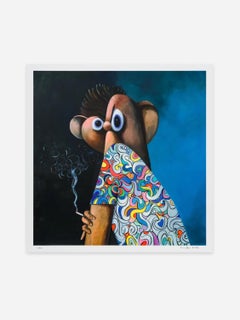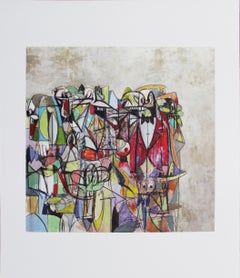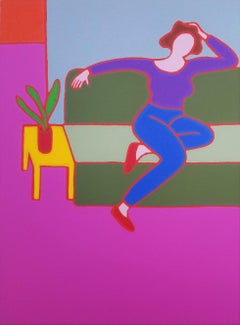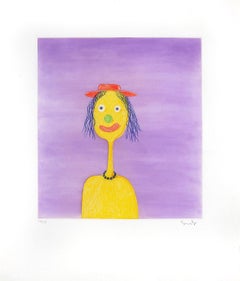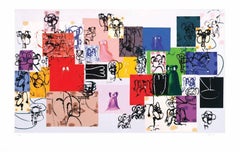George Condo Figurative Prints
American, b. 1957
George Condo was born in Concord, New Hampshire in 1957. He attended the University of Massachusetts, in Lowell, where he studied Music Theory and Art History. Condo’s art can be viewed as a multilayered experience that brings the viewer in touch with a psychological exploration of human nature. Through the process of transformation involving art historical language and an actualization of philosophical content, Condo’s paintings create a visible window into the world we live in.
His work is in the permanent collections of the Metropolitan Museum of Art, New York; Museum of Modern Art, New York; The Solomon R. Guggenheim Museum, New York; Whitney Museum of American Art, New York; Albright-Knox Art Gallery, Buffalo; The National Gallery of Art, Washington D.C.; The Museum of Fine Arts, Houston, The Judith Rothschild Foundation, Philadelphia; Broad Art Foundation, Los Angeles; Marciano Art Foundation, Los Angeles; Tate Modern, London; Centre Georges Pompidou, Paris; Fonds National d’Art Contemporain, Ministère de la Culture, Paris; Fonds Regional d’Art Contemporain, Ile de France, Paris; Staedel Museum, Frankfurt; Dakis Joannou Collection Foundation, Athens; Astrup Fearnley Museum of Modern Art, Oslo; Museu d’Art Contemporani, Barcelona; the Doron Sebbag Art Collection, ORS Ltd., Tel Aviv; Museo Jumex, Mexico City; and Moderna Museet, Stockholm.
Condo has been invited to lecture at many prestigious institutions including Columbia University, Yale University, Pasadena Art Center, San Francisco MOMA, The Solomon R. Guggenheim Museum, New York, and the Metropolitan Museum of Art, New York. Mr. Condo taught a six-month course at Harvard University entitled Painting Memory. In 1999 Mr. Condo received an Academy Award from the American Academy of Arts and Letters; in 2005 he received the Francis J. Greenberger Award; in 2013 Condo was honored by the New York Studio School; in 2018 he was a BOMB Magazine 2018 Anniversary Gala Honoree. Condo recently performed, painting live, on-stage in Anthony Roth Constanzo’s Glass Handel, an opera co-produced by the Philadelphia Opera and National Sawdust, featuring the music of George Frideric Handel and Phillip Glass.
In 2019, Condo was selected to participate in the 58th International Art Exhibition La Biennale di Venezia: May You Live in Interesting Times, curated by Ralph Rugoff. Condo was also the subject of a major retrospective of works on paper titled The Way I Think at the Phillips Collection in Washington D.C., in early 2017, which travelled to the Louisiana Museum of Modern Art in Denmark in the Fall of 2017. In 2016 Condo’s work was the feature of a museum-wide exhibition, Confrontation, at the Staatliche Museen zu Berlin – Museum Berggruen, Berlin, curated by Udo Kittelmann. In 2011, the New Museum, New York presented the retrospective exhibition, Mental States. This exhibition travelled to Museum Boijmans Van Beuningen, Rotterdam; Hayward Gallery, London; and Schirn Kunsthalle, Frankfurt.
EDUCATION
1976-78 Lowell University, Massachusettsto
2
2
1
Overall Width
to
Overall Height
to
2
1
18
847
382
381
308
3
3
1
1
1
1
1
2
1
2
1
Artist: George Condo
Lost in Time, George Condo Print
By George Condo
Located in Manchester, GB
George Condo, Lost in Time, 2024
22 colour silkscreen with spot colours on 600gsm Somerset Tub-Sized Radiant White paper80.4 x 81 cm (31.65 x 31.89 in)
Edition of 98 of 150
Hand-sig...
Category
2010s Contemporary George Condo Figurative Prints
Materials
Screen
Plate 1 Comic Relief
By George Condo
Located in Washington , DC, DC
Released as part of a portfolio in a limited edition of 400 on the occasion of George Condo's exhibition "Drawing Paintings" at Skarsketdt Gallery in 2011. Unsigned and unnumbered
S...
Category
2010s Abstract George Condo Figurative Prints
Materials
Offset
$2,280 Sale Price
64% Off
Plate 13, Compression IV
By George Condo
Located in Washington , DC, DC
Released as part of a portfolio in a limited edition of 400 on the occasion of George Condo's exhibition "Drawing Paintings" at Skarsketdt Gallery in 2011. Unsigned and unnumbered
S...
Category
2010s Abstract George Condo Figurative Prints
Materials
Offset
$2,280 Sale Price
64% Off
Related Items
Waiting /// Contemporary Pop Art Interior Figurative Sofa Colorful Screenprint
By Dan May
Located in Saint Augustine, FL
Artist: Dan May (American, 1955-)
Title: "Waiting"
*Signed and numbered by May in pencil lower left
Year: 1986
Medium: Original Screenprint on unbranded soft-c...
Category
1980s Contemporary George Condo Figurative Prints
Materials
Screen
$500
H 15.38 in W 12.32 in
Paris Review Poster
By Robert Rauschenberg
Located in New York, NY
A very good impression of this early color offset lithograph on white wove paper. Signed, dated and numbered 8/150 in felt-tip pen and black ink by Rauschenberg...
Category
1960s Modern George Condo Figurative Prints
Materials
Color, Lithograph, Offset
Original World Cup USA 94 - Coca Cola Soccer poster
Located in Spokane, WA
Original World Cup USA ’94, Coca Cola sponsored vintage poster. Archival linen backed in A- condition, ready to frame. This World Cup ’94 poster is very rarely seen or available....
Category
1990s Abstract Geometric George Condo Figurative Prints
Materials
Offset
Down to the Valley by Bill Schenck
By Bill Schenck
Located in Phoenix, AZ
Down in the Valley
Bill Schenck
Serigraph 46/50
Edition of 50
Image size: 25 x 29 inches
Paper size: 31 x 35 inches
SHIPPING CHARGES INCLUDE SHIPPING, PACKAGING & INSURANCE
UNFRAM...
Category
1990s Contemporary George Condo Figurative Prints
Materials
Screen
Rome Qantas Airlines travel poster linen backed
Located in Spokane, WA
Original Vintage "Rome Qantas" Vintage Travel Poster, Linen Backed, 1960s. Excellent condition. See images. Abstract style design of ancient Roman ruins.
An original mid-century...
Category
1960s Abstract Expressionist George Condo Figurative Prints
Materials
Offset
Tate Gallery (Marilyn)
By (after) Andy Warhol
Located in New York, NY
A very good impression of this offset color lithograph poster on heavy white wove paper.
Category
1970s Pop Art George Condo Figurative Prints
Materials
Color, Offset
Female Portrait (Head of Black Woman) Black Artist
Located in Wilton Manors, FL
Ellen Tiberino (1937-1992).
Head of Woman, ca. 1980. edition 450.
Offset print on paper, image measuring 15.5 x 21 inches. 21.5 x 27 inches in matting.
Hand signed and numbered i...
Category
1970s Abstract George Condo Figurative Prints
Materials
Offset
$350
H 21 in W 15.5 in
Person with colors
By Katherine Bradford
Located in London, GB
Twenty six colour screen print on Somerset 410gsm tub sized satin radiant white paper. Published in 2024. Edition of 75. Mint condition, unframed, stored flat.
Hand signed and numbe...
Category
2010s Contemporary George Condo Figurative Prints
Materials
Screen
Alexander Calder lithograph (derrière le miroir)
By Alexander Calder
Located in NEW YORK, NY
Alexander Calder Lithograph c. 1967 from Derrière le miroir:
Lithograph in colors; 15 x 11 inches.
Very good overall vintage condition; well-preseved.
Unsigned from an edition of u...
Category
1960s Abstract George Condo Figurative Prints
Materials
Lithograph, Offset
Champion by Billy Schenck
By Bill Schenck
Located in Phoenix, AZ
SHIPPING CHARGES INCLUDE SHIPPING, PACKAGING & **INSURANCE**
Champion 1979
Billy Schenck
Serigraph
Image size: 16 x 27 inches
Billy Schenck has been known internationally for 44 ye...
Category
1980s Contemporary George Condo Figurative Prints
Materials
Screen
Patrick Nagel 'Commemorative #11' Serigraph Print, 1987
By Patrick Nagel
Located in San Rafael, CA
'Nagel Commemorative Eleven' (NC 11), 1987
Serigraph on 100% cotton archival grade heavyweight rag paper
Published by Mirage Editions, a limited run edition, signed in plate
Printed ...
Category
1980s Contemporary George Condo Figurative Prints
Materials
Screen
Bacon, Portrait Isabel Rawsthorne, 2003 (after)
By Francis Bacon
Located in Fairfield, CT
Artist: Francis Bacon (1909-1992)
Title: Portrait Isabel Rawsthorne
Year: 2003
Medium: Offset Lithograph on premium paper
Size: 39.25 x 27.5 inches
Condition: Excellent
Notes: Publis...
Category
Early 2000s Abstract Expressionist George Condo Figurative Prints
Materials
Lithograph, Offset
Previously Available Items
Clown, 1989
By George Condo
Located in Palo Alto, CA
George Condo, Clown 1989
Created in 1989, this etching and aquatint is hand-signed by George Condo in the bottom right.
About the Framing:
George Condo, Clown 1989 is framed to mu...
Category
1980s Modern George Condo Figurative Prints
Materials
Etching, Aquatint
Paper Faces
By George Condo
Located in New York, NY
This screen print was created by George Condo and published by Lincoln Center Vera List Program. This work is signed and numbered by the artist, and printed on museum quality, archi...
Category
Early 2000s Contemporary George Condo Figurative Prints
Materials
Screen
Paper Faces
By George Condo
Located in New York, NY
This is a serigraph print.
Total Edition size: 108 plus 18 APs
Category
Early 2000s George Condo Figurative Prints
Materials
Screen
George Condo figurative prints for sale on 1stDibs.
Find a wide variety of authentic George Condo figurative prints available for sale on 1stDibs. You can also browse by medium to find art by George Condo in offset print and more. Much of the original work by this artist or collective was created during the 21st century and contemporary and is mostly associated with the abstract style. Not every interior allows for large George Condo figurative prints, so small editions measuring 10 inches across are available. Customers who are interested in this artist might also find the work of Frank Arnold, Michael Hurson, and Graham Fransella. George Condo figurative prints prices can differ depending upon medium, time period and other attributes. On 1stDibs, the price for these items starts at $2,850 and tops out at $2,850, while the average work can sell for $2,850.
